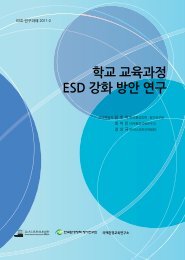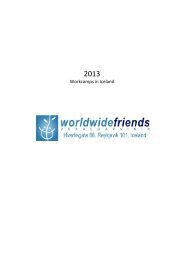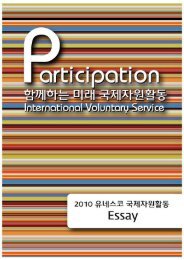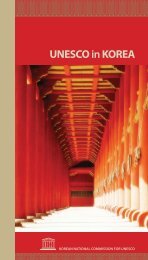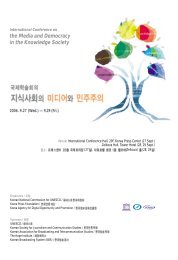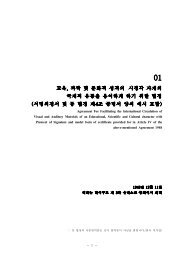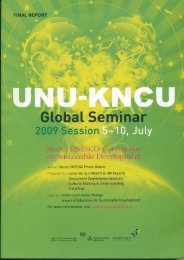íëìë³´ë2012문íì ë°ì ë¼ì´ëí ì´ë¸.pdf - ì ë¤ì¤ì½íêµììí
íëìë³´ë2012문íì ë°ì ë¼ì´ëí ì´ë¸.pdf - ì ë¤ì¤ì½íêµììí
íëìë³´ë2012문íì ë°ì ë¼ì´ëí ì´ë¸.pdf - ì ë¤ì¤ì½íêµììí
You also want an ePaper? Increase the reach of your titles
YUMPU automatically turns print PDFs into web optimized ePapers that Google loves.
paradigm of sustainable development, it has yet to build a high level of global governance<br />
system in the fields of culture and development as it had to address environment and climate<br />
change.<br />
The goal of this study is to help build the correlation between culture and development and<br />
thereby ensure the effectiveness of international development cooperation. Ultimately, it<br />
seeks to lay down the foundation for future discussion regarding culture and development<br />
that will become the basis for the establishment of a global system of cultural governance.<br />
For this purpose, this study will first attempt to develop a correlated network of culture and<br />
development through classification and case study.<br />
Culture and development are familiar concepts to all but there have been few efforts for<br />
their systematic classification. This study will first refer to the classification by the (cultural)<br />
heritage economist Throsby (2012) who, in his paper on the “Economics of (Cultural)<br />
Heritage”, divided the values of cultural heritage into economic and cultural values.<br />
First, economic value consists of two subcategories: use value and non-use value. The<br />
former refers to the value of cultural heritage as a consumable good enjoyed by individuals,<br />
while the latter refers to the value of cultural heritage as public goods 3 . For instance, the<br />
restoration of an old building may enhance its use value and enable a higher rent, thus<br />
increasing benefits for the landlord. Also, if the restoration of historic buildings provides an<br />
opportunity for tourists to revisit them and the improvement of the cityscape increases the<br />
satisfaction of its citizens, this translates into better individual welfare. On the other hand,<br />
non-use value is indiscernible in the market. Divided into present and future values, this is a<br />
common value found in cultural and environmental goods (i.e. environmental assets).<br />
Therefore, one may borrow the methodology of evaluating non-use value from the field of<br />
environmental studies 4 .<br />
Second, while cultural value, unlike its economic counterpart, is hard to quantify, it does<br />
generate a wide range of cultural effects: (a) aesthetic value that enhances environmental<br />
value; (b) symbolic value that defines the identity and cultural code of communities; (c)<br />
spiritual value that instills cultural conviction in citizens; (d) social value that promotes social<br />
stability through increased solidarity; (e) historical value that uses cultural heritage as a<br />
<br />
3 Throsby, David (2012), “Heritage Economics: A Conceptual Framework”, in Guidl Licciardi and Rana<br />
Amirtahmasebi (Eds.) The Economics of Uniqueness: Investing in Historic City Cores and Cultural Heritage<br />
Assets for Sustainable Development, The World Bank; Washington D.C. pp. 52-55.<br />
4 See Nijkamp, Peter (2012), “Economic Valuation of Cultural Heritage,” in Guidl Licciardi and Rana<br />
Amirtahmasebi (Eds.), The Economics of Uniqueness: Investing in Historic City Cores and Cultural Heritage<br />
Assets for Sustainable Development, The World Bank; Washington D.C.



